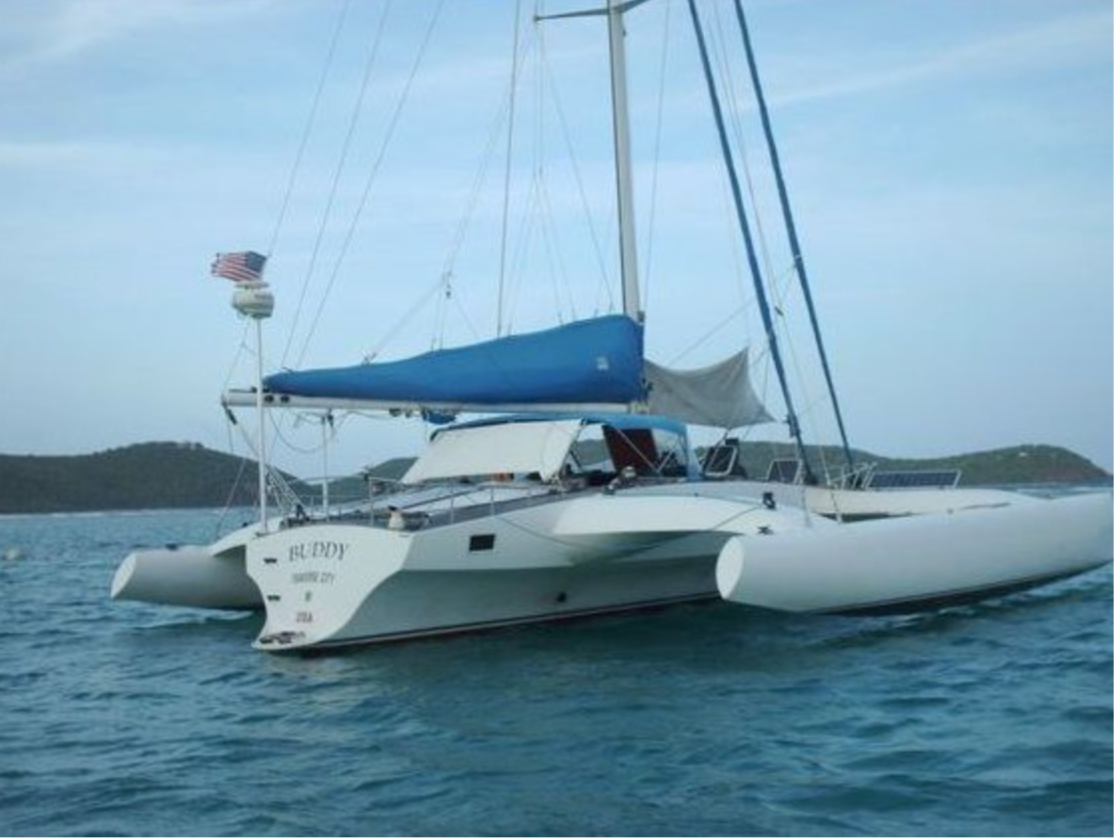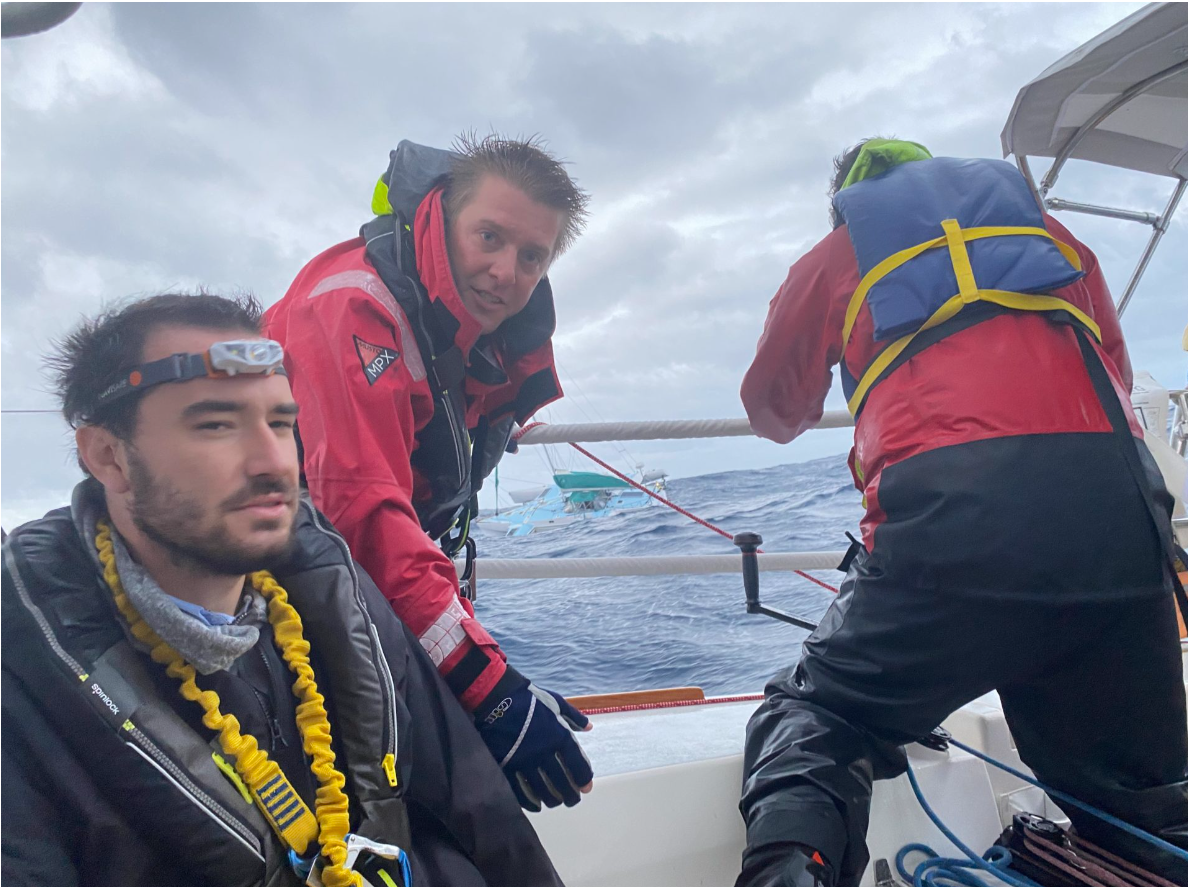Trimaran Sinks and Crew - Saved in Textbook Rescue

When the J/133 Vamoose diverted from their delivery to Antigua for a rescue, Willie Dresser shared their story of pulling the crew off the 44-foot custom trimaran Buddy. Then, Ryan Finn who was on the sinking boat reported his view of events.
Both of these azccounts have appeared in Scuttlebutt Sailing News, and the reports have been conflated by BoatTEST editors in order to get perspectives from both he rescued and the rescuers.
Ryan Finn, from the doomed 44’ trimaran Buddy: On December 1st, I departed on a delivery from Woods Hole, MA to Puerto Rico, with the owner Laura Shulman and crew Tomasz Dvorak. We left in a NW wind, 25-35 knots with only a staysail up and sailed conservatively with wind aft of beam, towards the Gulf Stream.
As we approached the wind became lighter and we hosted the mainsail, until ultimately, we were motor sailing safely across the Gulf Stream. We exited the Gulf Stream in light upwind conditions which increased and swung aft through the evening.
In the early morning hours on December 4th, we were close reaching at 8-10 knots with a staysail and double reefed mainsail, with wind gusting to 30 but very manageable.

I was awakened at around 4:00 am by something, and came on deck to see what was happening. Boat speed had fallen to nearly zero, and a quick look to leeward showed the ama underwater with only the deck visible. It was obvious that it had a big hole from a collision, since Laura Shulman noted our abrupt stop, and it filling completely with water.
Buddy began to slowly capsize over the next four hours. During that period, we doused all sails, put on life jackets, and began untying the rigid inflatable we had lashed to the port trampoline. Our attempts to motor Buddy under her own power were useless as we could only make one knot at full throttle, and we had no steerage with the weight/drag of all that water on the port side.

During this time we were also in communication with the J/133 Vamoose, who was roughly 10 miles upwind, to our west. They were on standby waiting for our decision. After it was clear that we couldn’t rescue the boat under its own power, we decided to abandon ship and told Vamoose that we would like a rescue.
From the Rescue Vessel
Willie Dresser from the rescue boat the J/133 Vamoose. We received a call December 4 at 4:20am from the 44-foot custom trimaran Buddy asking if we can give assistance 250 nautical miles northwest of Bermuda. We wrote down their coordinates and discerned that they were about 10 miles behind us.
We continued a VHF conversation, taking down as much basic information as possible. We turned downwind toward them and established better coms, and quickly learned they were in trouble and needed assistance. Tim emitted an audible “holy sh#t” so I made the turn towards Buddy.

Their plan was to abandon ship when we got there. Geoff woke up Chris and told him what was going on. We altered course toward them eight miles away and began to talk about what we would do when got there. When we got in sight of the mast head light at about two miles away, we gathered our crew to make sure everyone knew what to do and the location of the first-aid kit.
Ryan Finn: We then turned off all electronics except for navigation lights and 12V outlets to keep the Iridium Go tracking device on, updating its position on the Predict Wind app, in hopes of arranging a tow from shore.
Roughly two hours into the event, the port ama started to fall apart, with about 8-feet of it tearing away between the beams. She began listing even more to port. We packed our small dry bags with passports, boat papers, and some personal gear and waited on deck with our ditch bag, handheld VHF, and EPIRB, ready to board the dinghy.
By daylight Vamoose appeared on the horizon. A little while later they were abeam of us, striking all of their sails. At this point Buddy began listing even more and it was clear that we had to get off the boat as soon as possible. Vamoose motored well to leeward and let us know by VHF that they were ready for us.

Tomasz climbed in first and received all of our gear, then Laura, then myself with the knife ready to cut the painter. Once the painter was cut, it took longer than expected for us to drift away from Buddy, the two drifting back and forth as if attached by bungee cord, probably a minute or two, but that’s not how it felt at the time. Eventually we broke away and drifted to a safe enough distance to board Vamoose.
Surprisingly, once drifting away, the 10-foot dinghy with three adults, 25-30 knots of wind and 10-foot waves, felt more secure than being on Buddy. Next thing we know the port bow of Vamoose was upon us and we boarded safely aft with all of our gear. The dinghy was left to drift away with Buddy.
Willie Dresser: Once we got abeam of the sinking trimaran, Geoff and Chris went up forward and fasted the jib and main. I proceeded to start the engine and round up from downwind of their boat. Geoff radioed to them that we were set to receive, so they proceeded to jump in their AB dinghy and drifted off.

The conditions were 15-foot breakers with 53 knot gusts recorded, and when we came around they were too close to the sinking sailboat, so we had to loop around and wait for them to drift off around 6-7 boat lengths. Once ready we took them at the gate on the port side and rounded over to them, so they were on leeward not getting the spray.
Ryan Finn: In communication with observers on land, we were told that Buddy’s tracker stopped transmission about an hour after we abandoned her, meaning she probably capsized. As far as near tragedies go, it couldn’t have gone more smoothly. Twenty-nine hours later, with borrowed clothes and new friends, we were safely in Bermuda having dinner at the White Horse Inn.
Word from the Designer
In discussions with the designer/builder John Patterson, he confirmed that there was a foam filled compartment from the forward beam to the bow and another from the aft beam to the stern of each ama. This means that the forward compartment was breached into the central compartment of the ama, allowing a lot of water into it at once. We never saw anything floating nearby as it was still dark and too dangerous to investigate underwater and to leeward.
We felt it was wise to stay put and be prepared to board the dinghy which was ready with a single painter to be released.

The Inevitable Second Thoughts
A lot went through my head at the time for getting Buddy to port on her own bottom. I considered cutting the rigging away to reduce weight and windage aloft, but there’s a lot of danger in doing that with steel rigging on the windward ama. Getting out there for the operation would have been dangerous (Buddy’s trampoline only goes halfway across to the ama for launching and retrieving the dinghy).
The other idea was to partially flood the windward ama to counter the weight of the breached one, but that too would be very risky and something about adding more water at that time made me very uncomfortable. Another idea was to cut the port ama off and go proa, but there was no way to do that with what we had on board, as it would have required sawing away underwater if we wanted to keep the mast up. Still too dangerous.
These were fleeting ideas though, and the #1 priority was getting off safely, which we achieved. Once we heard that the tracker stopped transmitting, I don’t think any of us had regrets about our decision to abandon Buddy, and live to sail another day. She was a beautiful trimaran though.
The Role of Technology
The technologies that made this rescue possible need to be noted here. Without them, we would have had to be rescued by the Coast Guard, in whatever capacity they chose, as opposed to sailing into Bermuda under spinnaker with some of our possessions and all of our bodies intact.

At the helm station we had a tablet in a waterproof case. Using Navionics on the tablet, it showed Vamoose’s position on AIS. The AIS transmission allowed them to sail directly to our position, not wasting a minute, and in light of the likely capsize, all those minutes counted
Without these technologies working so well, this could have been a much more complicated and potentially tragic story. If you ever wondered if they were worth getting for your next offshore passage, the answer is a resounding YES!